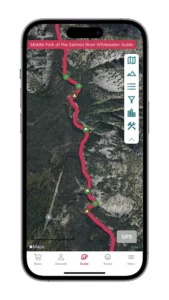About Lake Creek
Heavy rain battered Lake Creek, a tributary just upstream of Pistol Creek Rapid, on July 24, 2006. A previous fire had burned this small, steep tributary to the ground, leaving its boulders, soil, and dead trees unsettled. The rain saturated the earth, causing a “blowout,” which is a mudslide that contains the burned material. This snowballed as it hurtled downhill through the Lake Creek canyon, picking up more and more debris. This blowout slammed about 60 logs into the river, as well as a wall of mud and other debris, when it reached the Middle Fork of the Salmon. The river was high for this time of year, but low overall, at slightly over 2 feet, despite the fact that it was late July. (The Middle Fork is traditionally measured in feet, 2 feet is just over 1,000 CFS.)
The combination of low water, the number of logs, and the river constricting in Pistol Creek Rapid proved problematic as the logs jammed at the S-turn pinch point in Pistol Creek Rapid, creating an impassable section of the river.
This event was picked up by the river gauge, which is located at the Middle Fork Lodge, located just under 13 miles from Pistol Creek Rapid. Rafters who had started their trips upriver at Boundary Creek began to arrive shortly after. The river had backed up, forming a new lake and burying the original river channel in debris. The various groups were unable to continue downstream and came to a halt on river left at Lake Creek, unsure of what to do. As more and more groups arrived at Lake Creek, the problem grew worse, and with nowhere to go, the improvised camp became overcrowded.
The Forest Service eventually flew in a crew that included a blasting specialist who dynamited the logjam, allowing the river to flow freely again. According to legend, a USFS fish biologist was also flown in, and the blaster promised him that “the fish won’t feel a thing.”
Over the following months and first couple of years, Lake Creek Rapid changed immensely as the new material settled and adjusted with seasonal high water. Today, it looks nothing of its former self and requires some maneuvering around a hole located on the right that appears at higher flows but nothing very challenging.





